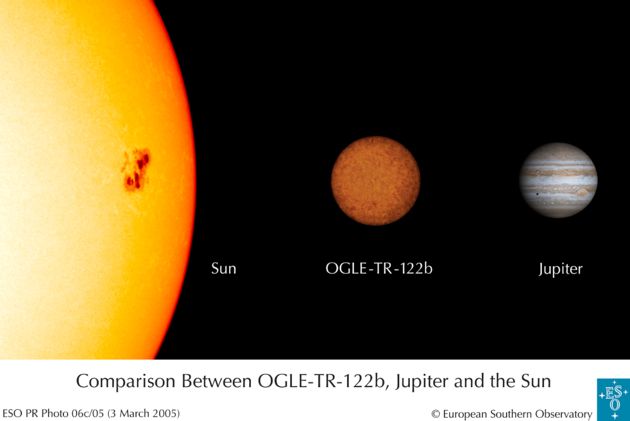Newfound Star Smaller than Some Planets

Astronomers have found the tiniest full-fledged star known, an object just 16 percent bigger than Jupiter. It is smaller than some known planets that orbit other stars.
The star is a companion to a Sun-like star toward the center of our Milky Way Galaxy. It was found and measured by observing changes in the light output of the system when the smaller star passes in front of the larger star from our vantagepoint.
The discovery helps astronomers better understand a gray area of definition concerning stars and planets.
Between planets and stars, there exist odd objects called brown dwarfs. They're often referred to as failed stars, because they don't have enough mass to trigger the thermonuclear fusion that powers real stars, like the Sun. A brown dwarf is typically several times the mass of Jupiter, but astronomers haven't determined the exact size or mass cutoffs on either end.
The new discovery, announced Thursday, puts a firm diameter measurement on the smallest star that does in fact shine normally.
The result shows stars less than one-tenth the mass of the Sun can generate thermonuclear fusion while being barely bigger than Jupiter.
"Imagine that you add 95 times its own mass to Jupiter and nevertheless end up with a star that is only slightly larger," suggests Claudio Melo European Southern Observatory (ESO). "The object just shrinks to make room for the additional matter, becoming more and more dense."
Get the Space.com Newsletter
Breaking space news, the latest updates on rocket launches, skywatching events and more!
The star is more than 50 times as dense as the Sun. It is smaller than some extrasolar planets, including one world that is 30 percent larger than Jupiter.
"This result shows the existence of stars that look strikingly like planets," said Frederic Pont of the Geneva Observatory in Switzerland, another member of the study team.
The diminutive star was initially discovered as part of the Optical Gravitational Lensing Experiment (OGLE) survey, which identified several dozen stars toward the center of our galaxy that appeared to have something moving in front of them. The diameter measurements were done from the ESO's Paranal Observatory in Chile.
The star is named OGLE-TR-122b. It orbits the larger star once every 7.3 days. Because of its relatively low mass, the smaller star's nuclear energy production is low compared to a Sun-like star, the astronomers said.
Join our Space Forums to keep talking space on the latest missions, night sky and more! And if you have a news tip, correction or comment, let us know at: community@space.com.

Rob has been producing internet content since the mid-1990s. He was a writer, editor and Director of Site Operations at Space.com starting in 1999. He served as Managing Editor of LiveScience since its launch in 2004. He then oversaw news operations for the Space.com's then-parent company TechMediaNetwork's growing suite of technology, science and business news sites. Prior to joining the company, Rob was an editor at The Star-Ledger in New Jersey. He has a journalism degree from Humboldt State University in California, is an author and also writes for Medium.
